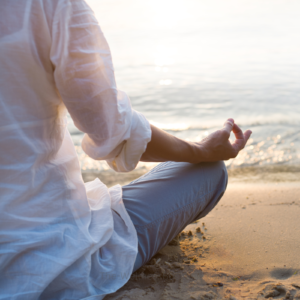Dharana or Concentration:
Dharana or concentration or single mindedness is first stage of dhyana or meditation. In Dharana yogi/yogini wheels the mind to an object. Mind is very active & always wondering from thought to thought. Sometimes it is noticing things in front of us & in split of second it might be at other side of the world. Rishis or ancient sages believed that if we use minds full potential by directing the mind to what to do, rather than letting mind be in driver’s sit, we can achieve a lot. Highest stage of mental concentration described by the modern psychology is similar to the description of Dharana in the yogic scriptures, which is considered as primary stage of concentration by these scriptures. There 2 more stages after dharana that which we will discuss letter.
To reach the state of Dharana it in important to wheel or direct the mind towards an object. Biggest distraction for mind is through five sensory organs. This object can be a flame of ghee lamp/candle, a yantra or geometrical diagram, mantra, nada/sound or concentrating on physical part of body like tip of nose or area between eyebrows. Directing your all senses towards this object by slowing down fluctuations of mind & training the mind of single point awareness is aim of dharana. Our mind is very important for our function, but you may notice that we are ruled by mind rather than mind is ruled by us. Dharana teaches us to control & direct the force of mind.
Creating atmosphere for the Dharana practice is also very important. For e.g. clean environment, gentle lighting, quiet place, comfortable clothing etc. choose a seated position in which you can seat comfortably for longer period of time. Keeping spine elongated is very important. Initially begin by just 10 to 15 minutes of practice then slowly increasing the time also regularity of practice is very important. There are many ways to do dharana, these yoga practices exist to improve concentration of the mind and train the mind. Some of those are:
- Concentrating on certain part of body like heart center or navel while practicing yoga asanas & holding the poses with all your awareness towards this part of your body.
Repetition of mantra: Mantra can be “om” or any other mantra of you choice. Sitting comfortably may be placing the symbol of “om” in front of you(eye level but not too close or too far) bring all your attention to this symbol by gently gazing at the symbol begin chanting om, with your ears listen to this sound keeping all your listening towards this chanting. After some times close your eyes & become aware of just the sound of mantra. After few days of regular practice you can slowly begin adding one more stage to this practice, which is mental repetition of the mantra.
There are may more practices like trataka or candle gazing in which it is important that candle should be made out of natural wax or using a ghee lamp. Also making sure that the flame is gentle. Correct Trataka practice should be learned from experience yoga teacher.
Yantra or geometric diagrams are very powerful symbols which are said to appear to the Rishis in their meditation practices. These can be used for dharana practice.
Initially if it is difficult to sit for 10 minutes begin with 5 minutes slowly increase the time. Rather than forcing the mind gently directing it towards the practice is very important
Dhyan or Meditation:
Dhyan or Meditation is a wonderful gift to mankind. All realigns encourage us to meditate. Meditation brings sense of clam, wellbeing & true happiness. Through meditation we understand the truth which helps us lead better life, our relationships improve, have better health & better understanding of the world. We can let got of unnecessary worries & false assumptions. Meditation teaches us acceptance, forgiveness & to go with the flow.
There are many types of meditations. In “Vidnyan Bhairava Tantra” 112 meditations are explained. There are many ways to meditate for e.g. meditating on breath, mantra, chakras, watching your thoughts, visualization, compassion etc. there are mediations in which even these gross or subtle objects are not used.
Choosing what is right for you by trying different types of mediations is important. Whichever meditation technique is chosen doing it at least 21 consecutive days, (preferably same time of the day) will help you make decision. Notice what feels right also noticing effects of practice & then after 21 days see if you want to continue or try new technique. Meditation should be simple & relaxing. Unlike concentration where we are putting effort into concentrating mediation should be effortless. For some people initially it takes some time for mind to clam down, be patient. Gently directing mind towards the meditation will help. Sometimes some people experience that they sleep during the meditation, this happens because body is so tired that it needed that rest. Taking enough sleep & rest will help to stay aware during mediation. Sometimes sitting for longer period of time is difficult or body is not happy to sit for longer period of time, Yoga asana practices helps to increase capacity to sit comfortably for longer period of time. Sometimes people think that meditation is easy or it means doing nothing or being stagnant or sometimes mediation is considered to be very hard, it is neither. It is what it is & only thing to do is experience.
Meditation clams our mind so that we see reality more clearly. Imagine our mind is a beautiful lake & due to movements of air & falling of leaves surface of water has lots of ripples. Due to these ripples it is difficult to see hidden treasure at the bottom of the lake. To see this treasure water needs to clam down & become still. Once that happens we can see the treasures at the bottom of the lake very clearly. Similarly if we clam down our mind we can see our true self or the reality. Initially we might see this treasure once in a while but with practice of sitting quietly on the bank of this lake & observing the lake we come to know when exactly the treasure will be more visible, patience & dedication is important. Effects of meditations can be seen on every aspect of the life. They filter though each & every aspect of our being. We become more aware, more stress free, more clam & happy.
Here is one of my favorite meditations:
Choose a quite, clean area of the house, sit comfortably with your spine elongated, and begin by noticing sounds around you. For few seconds bring all your awareness towards into listening and then gently let go of this awareness of listening. Now for few seconds become aware of your whole body. & then gently let go of this awareness. Now bring awareness towards your breath, just observe rhythm of your breath, not judging just observing. If mind wonders bring it back towards breath. Just watch your breath. Just for few minutes everyday sit in silence & watch your breath. You will notice slowly you can increase time of your meditation.
Samadhi or Total Bliss:
Samadhi is a state of total bliss or non-dualistic state where truth is realized. It is state of true happiness or blissfulness. In Samadhi we can experience the ultimate reality of our existence. This is the stage where yogi/yogini becomes one with the divine or atama & peramatma becomes one.
Throughout our life we are searching for happiness. If we look around us all of us are looking for happiness in some form or the other. We look for happiness in material objects, relationships etc. Most of us are looking outside for this happiness & that is main cause of sufferings. Our mind is constantly working, even in our sleep mind is weaving web of dreams. Through regular meditation practice we can train our mind to become still. And when mind becomes still we begin to uncover the truth. That is Samadhi.
In scriptures different stages of Samadhi are given. Such as:
- Savitarka Samadhi is where attention is on gross objects like mantra, chakras etc.
- Savichara Samadhi is where awareness is towards subtle objects like elements, prana etc.
- Sananda Samadhi is where awareness is beyond gross or subtle objects. In this state the awareness is towards bliss.
- Sasmita Samadhi is where awareness is beyond gross, subtle or sananda level. It is very deep state where awareness is towards self but not on ego. It is beyond ego. Asamprajnata Samadhi is an objectless stage where practitioners do not meditate on any object.
Meditation practices help our mind to calm down & help us to see the reality. With regular practice it is said that we can achieve Samadhi or total bliss. With regular practice spiritual guidance also plays crucial part. The scriptures mention that guru or spiritual guide is beyond teacher, guru that light which helps us to remove darkness of ignorance. It is said that when the time is right the guru will appear. Guru can make the path of Samadhi easier by directing the yogi/yogini towards right direction.
Loka samasta sukhino bhavantu
May all beings be well happy & free from sufferings.
Namaste,









